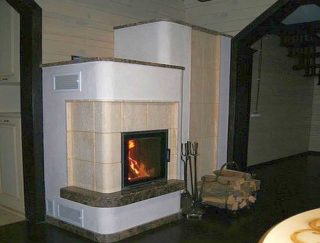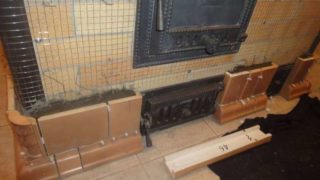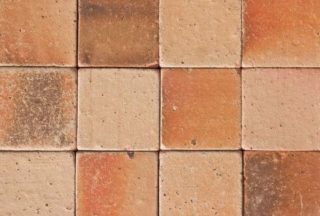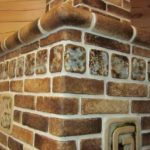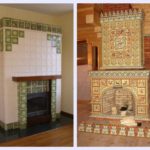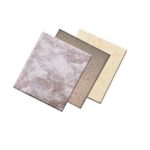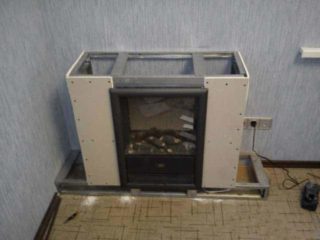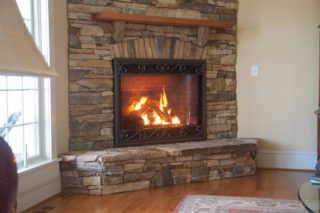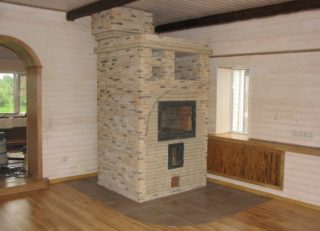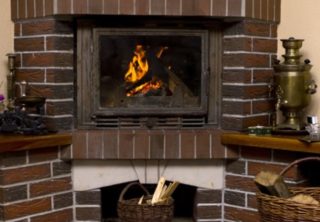The fireplace has attractive power. He is able to become the center of the house, the concentration of comfort. Not only the owners of country houses can afford it. For apartments make false fireplaces, replacing the living hearth. Fireplace lining - recognizable part of it. For decorative decoration, a number of different types of materials are used. You should understand what the choice of materials depends on, how to properly mount the decoration with your own hands.
Marble fireplace trim
A decorative portal of one marble will cost a round sum. Therefore, most people put a brick fireplace, and the facing part is made of marble. The material is mounted on a brick, foam concrete, aerated concrete. On any of these grounds, he looks rich.
Work with marble has its own characteristics. It is important to pay attention to the quality, texture of the material, if the fireplace performs not only decorative functions, but is also used to heat the room:
- Work with structured marble begins with the adjustment of the texture of pieces of material to each other. They are laid out according to a matching pattern, then marked out for cutting.
- When buying material pay attention to the integrity of the plates. Pressed marble chips are cheaper, but short-lived. For a decorative fireplace it does not matter - the temperature in it is low. For hot use of the furnace, the use of solid stone without pronounced cracks is correct. Actual quality of material for rarely heated fireplaces in refrigerated rooms. The temperature difference and the effect of condensate have a detrimental effect on pressed slabs of marble chips.
- The color of the material is also important. The user has his own preferences - light material or dark. However, dark tiles are easier to clean from dirt, greasy spots are hardly noticeable on them.
It is difficult to work with marble. For light stone, the formation of stains is critical. For these purposes adhesives using white cement have been developed. Fill the seams with specially designed mastic.
Marble care consists of the following procedures:
- weekly wiping the surface with a cloth moistened with warm water;
- cleaning old stains with special cleaning powders for marble;
- waxing;
- periodic processing of metal grills with anticorrosive compounds.
Cleaning marble with abrasive powders is prohibited. Compliance with the rules for caring for the material will extend his life for decades.
Fireplace Stucco
This is a simple, cheap way to decorate the portal. The use of different types will form a smooth or textured surface. With proper imagination, the texture of the stone is given to the plaster or the relief surface is laid out. Using the right formulations will allow the coating to hold onto the surface for decades. The scenery is easily painted and changed to suit the particular design of the hall. Unlike stone, it does not weigh much, easily forming on any frame of the portal.
Types of plaster
For a reliable finish of stoves and fireplaces, various types of plasters have been developed. For a false fireplace, it is quite non-heat-resistant, a working fireplace requires a different attitude. Heat-resistant plaster includes reinforcing threads of refractory material. They reliably protect the surface from cracking when heated. Durable and flexible material takes on all the load when changing the volume of the lining.
Manufacturers point to the versatility of mixtures - suitability for masonry and decoration. Experienced masters do not agree with these. For masonry, a composition with increased strength is required, for cladding - heat-resistant, plastic.
During installation, 4 main types of plaster are used:
- Mineral decorative. This type is created on a cement basis and is economical - the most budgetary of suitable coating options. It easily withstands temperature changes and humidity changes. Suitable for non-residential premises with rare use of the furnace. Lifetime tends to infinity.
- A mixture of acrylic and mineral elements. This type withstands temperatures up to 90 degrees and is suitable for a heating surface.
- Silicate based plaster with water glass. High vapor permeability and heat resistance make it one of the leaders in furnish for furnaces. The limitation is the high price.
- Coating with the presence of silicone resins. It has a water-repellent, antistatic effect. Not afraid of moisture, wet cleaning.
The correct selection of material and competent application extend the term of use of the coating. Do not neglect plastering technology.
Stucco Features
The latest mixtures for facing the fireplace are materials with additives, plasticizers, heat-resistant impregnations. Features of the finishing plaster for stoves and fireplaces:
- heat resistance;
- strength;
- wear resistance;
- elasticity in the solid state.
Heat resistance guarantees fire safety, because in the heating zone the temperature rises above 100 degrees. For this, asbestos or fiberglass is used.
Strength and wear resistance are the main components for many years of service.
Elasticity is provided in two ways: by applying to the reinforcing embedded mesh or wire, by introducing reinforcing fibers into the mixture. The latter counteract thermal deformation, stretching along with the material and linking the elements.
The plaster is applied to the dried mortar and the structure, which has undergone shrinkage. Freshly baked oven should stand for 1 month. Before surgery, the sutures are cleaned to a depth of 1 cm for additional grip.
It is possible to achieve good adhesion of the plaster with the base by applying a heat-resistant solution with deep penetration into the material. This is a logical solution when using dry mixes.
Self-made clay solution is applied in a similar manner. Part of it is made according to the consistency of liquid sour cream - the whole surface is sprayed with it. On a slightly dried surface, a basic solution is applied.
Technology for mounting tiles and porcelain tiles
For decoration, you can not use tiles for bathtubs - it will not withstand high temperatures. Therefore, we use special types of ceramics:
- Terracotta tiles. In terms of properties and appearance it resembles refractory brick for a fireplace. It is made of fired clay. Withstands temperatures of hundreds of degrees, having a coefficient of shrinkage of a simple brick. Pigments are not used, but the natural range varies from beige to dark red.
- Majolica. This material is created from fired clay, but is additionally painted with glaze on top. Its price is high, but the work looks interesting. Laying requires qualification, adjustment according to the drawing, work with a sketch. The slightest flaws are noticeable. Most often used in complex jewelry.
- Brick tile. Withstands heating by hundreds of degrees and the effects of condensation. It is made of refractory clay. Colors are natural in brown. Frost resistant.
- Fireclay brick tile. Accumulates heat and cools for a long time, withstands critical temperatures. Industrial furnaces at thermal power plants are laid out with similar material.
- Porcelain tile and tiles are assigned to a separate group.
- Fireclay tiles
- Majolica
- Porcelain Tiles
- Clinker
To install these types of tiles, standard glue will not work, a heat-resistant composition will be required. You can pick it up yourself, experiment with clay samples, solution humidity. It is easier to focus on the use of ready-made composition.
The number of tiles purchased with a margin of 10-15% - increase the number of standard and corner elements. You can mount the decoration yourself. Step-by-step description of work stages:
- Surface preparation is a guarantee of many years of coverage. The old lining is removed, the surface is cleaned and smoothed out, the seams are deepened by 1 cm. Irregularities are removed by heat-resistant mastic or clay mash. Weak masonry is necessarily strengthened by a metal mesh with a cell of 1-1.5 cm.
- The tile must be aged 2 days in the room. A fireplace for 3-6 hours is heated to give the bricks a natural deformation.
- The surface is cleaned of dust, primed and left for a couple of hours.
- The tile for the fireplace is laid on the floor, the configuration of the cuts is determined.
- The adhesive solution is prepared according to the instructions, mixed thoroughly.
- It is trimmed, starting from the corner elements, then moving on to the bottom row.
- Masonry mortar is a special spatula, preparing the area immediately for fixing 3-4 tiles. The vertical and horizontal laying is controlled by level. The distance between the tiles - crosses.
- Grouting of joints is carried out with special compounds or made with your own hands. Dyes are added for staining.
Uncoated tiles are coated with heat-resistant varnish - it will fill the pores of the material, facilitate future care. The work will look more colorful.
Drywall fireplace
This material is used when facing electric fireplaces. Any form of decoration is possible - broken, curved. Ease of working with the material contributes to its distribution. Low cost, ease of installation give scope to the imagination of the installer. Minus - low thermal resistance of the material, the need for additional decorative trim.
Installation steps:
- creating a portal frame from a metal profile;
- sheathing the frame with a magnesium glass sheet that can withstand heating up to 1200 degrees;
- filling the metal frame with basalt wool protecting the drywall from high temperatures;
- lining with refractory drywall, withstanding temperatures up to 130 degrees 40 minutes;
- during installation, holes are left for air circulation;
- a top coat of plaster, tile or tile is applied.
On the basis of drywall, you can easily combine several materials. For the decoration of a raised fireplace use any materials. He does not give strong heat.
Stone cladding
Facing the fireplace with artificial and natural stone looks organically. The stone has many advantages:
- heat resistance;
- environmental friendliness;
- chic appearance;
- durability;
- personality of natural stone;
- ease of installation, processing of artificial stone.
The stone cladding technique for a fireplace resembles tile laying. Allowed to leave gaps, creating an “artificial mess” in the installation. The stones are mounted on heat-resistant adhesive. Heavy are fixed on an anchor. The furnace is preheated, the stones are selected according to shades - the lower rows are made darker. Laying starts from the bottom row.
If desired, porous stones are coated with heat-resistant varnish. This makes it easier to care for them, while the fireplace glistens in the twilight.
Artificial gypsum stone
Such material is made on the basis of cement with the addition of expanded clay, crumbs, gypsum. The fill reflects the shape of natural stones.The cost of products is lower than natural, the weight is much less, easier to handle. Additives of dyes allow you to make stones of dozens of shades. Decorating a fireplace with this element is simple, does not require special skills. Unlike natural stone, it is easy to trim at the place of installation.
Work with a natural stone
Stone cladding resists temperature extremes. The decorative finish will depend on the type of stone:
- granite polished or "ragged";
- marble;
- shell rock;
- sandstone;
- sand shale.
Installation of natural stone is carried out using a metal mesh. Porous materials are easily formed for installation, but soot remains in the pores. Therefore, the surface is recommended to be coated with heat-resistant varnish.
Heavy rocks - marble, granite, basalt require accuracy during installation due to weight. Sometimes during installation, the creation of a power frame from anchors is required.
Combined Options
Facing the fireplace insert is more interesting in the combined version. The combination of stone and wood trim gives an original decorative look to the living room. Finishing with modern materials can be interspersed with marble or natural stones, combine wooden elements and stone, thermal tiles and drywall.
Wood trim seems undesirable from the fire safety side, but processing with non-combustible materials makes the wood resistant to heat. It is advisable to use it for framing a fireplace portal, making a mantelpiece. It is advisable to use heat-resistant breeds - alder or ash.
In combined decoration, the technique of separating the lower and upper zones of the fireplace is used. Heavy materials are laid below, wood and plaster above. This finish divides the areas of use: stove, place for firewood, mantelpiece, chimney trim.
Finishing options are selected individually for each case. They are affected by the location of the fireplace, the decor of the room, the intensity of the use of heating, the condition of the house. The main thing is not to rush and coordinate actions with the instruction.

